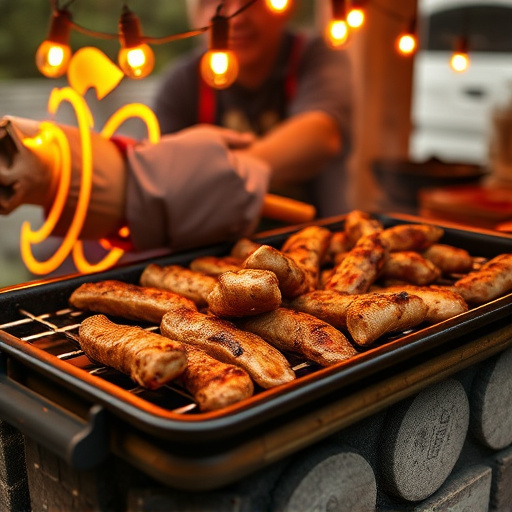Crafting the perfect BBQ jerky starts with choosing lean cuts like beef round or tenderloin for crispy, flavorful results. Marinating with soy sauce, vinegar, citrus, garlic, and spices creates custom flavors. Air drying at room temp or using an oven ensures ideal texture, while grilling at 225°F (107°C) enhances flavor. Store jerky airtight at room temp up to a week, fridge for 2 weeks, or freeze for longer. Experiment with global flavors like jalapeño teriyaki or Moroccan spices for unique, exciting BBQ jerky recipes.
Get ready to elevate your summer grilling game with this ultimate backyard BBQ jerky recipe. Discover the secrets behind crafting perfect, chewy, and flavorful meat snacks right in your own kitchen. From choosing the ideal cut of meat to mastering marinade magic and drying techniques, we’ll guide you through every step. Learn tips for even cooking on the grill and explore creative flavor variations to impress your family and friends. Bring the taste of summer into your home with this delicious DIY BBQ jerky recipe!
- Selecting the Best Cut of Meat for BBQ Jerky
- Marinade and Seasoning: The Heart of Your Jerky
- Drying Techniques for Perfect Texture
- Cooking on the Grill: Tips for Evenly Roasted Jerky
- Storage and Shelf Life of Homemade BBQ Jerky
- Creative Flavor Variations for Your Summer Grilling
Selecting the Best Cut of Meat for BBQ Jerky
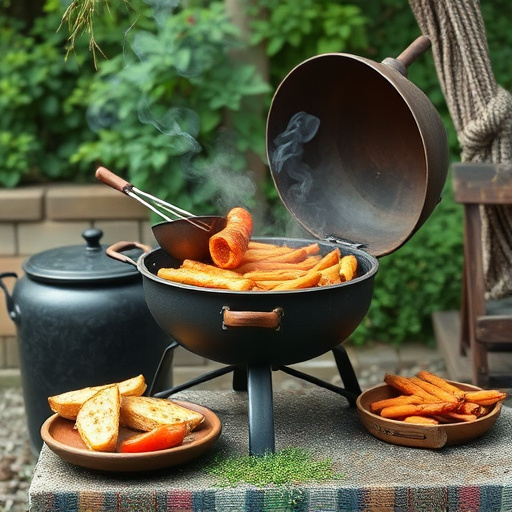
When crafting your perfect BBQ jerky recipe, choosing the right cut of meat is a crucial step. Opting for lean protein ensures your jerky turns out crispy and not greasy. The best option is often beef round or tenderloin—these cuts are lean and have good marbling, which adds flavor without excess fat. Marbling is the intramuscular fat that enhances taste; too much fat can make your jerky tough and less enjoyable to eat.
Consider the texture you want in your BBQ jerky recipe as well. For a chewier, more satisfying bite, choose cuts like brisket or chuck. If you prefer tender, easily shredded jerky, go for thin slices from the round or tenderloin. The cutting and thickness of your meat will significantly impact how your jerky turns out, so select according to your desired final product.
Marinade and Seasoning: The Heart of Your Jerky
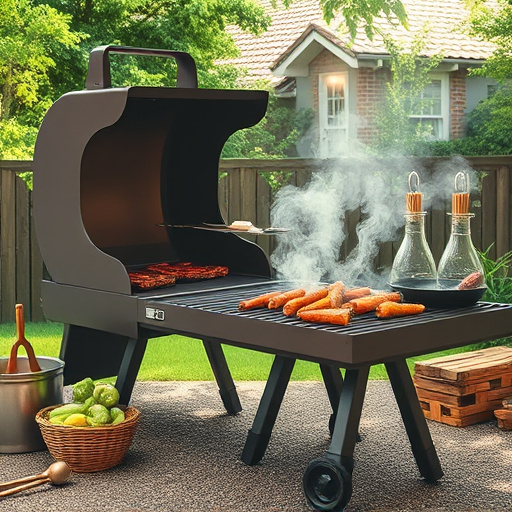
Marinade and seasoning are the key elements that transform simple meat into mouthwatering, tender BBQ jerky. The right combination can elevate your backyard BBQ Jerky Recipe to new heights, offering a burst of flavor with each crispy bite. A good marinade not only moistens the meat but also penetrates it, infusing savory juices and spices that enhance its natural taste.
Experimenting with different bases – such as soy sauce, vinegar, or citrus juices – allows you to create diverse profiles. Add in garlic, onions, ginger, and chili for a spicy kick, or opt for herbs like thyme, rosemary, and oregano for a classic, smoky flavor. The heart of your perfect BBQ jerky lies in balancing acidity, sweetness, saltiness, and heat to suit your taste preferences.
Drying Techniques for Perfect Texture
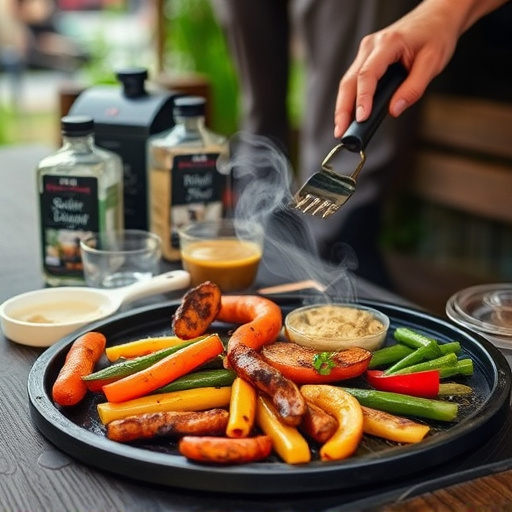
Achieving the perfect texture in your DIY BBQ jerky is key, and understanding drying techniques is essential. After marinating your meat (typically beef, chicken, or turkey), the next step is crucial—drying. You have a few options here, each offering unique advantages. The most common method is air drying, which can be done at room temperature for several hours or even days, depending on humidity levels and desired tenderness. This slow process ensures a lean, tender jerky with a rich, smoky flavor from the BBQ marinade.
For those seeking a faster alternative, an oven can speed up the process while still producing excellent results. Set your oven to its lowest temperature, typically around 170°F (77°C), and use a wire rack to hang your meat strips, ensuring good air circulation all around. This method is ideal for larger batches or when time is of the essence. Remember, though, that too-fast drying can lead to tough jerky, so monitoring the process closely is vital.
Cooking on the Grill: Tips for Evenly Roasted Jerky
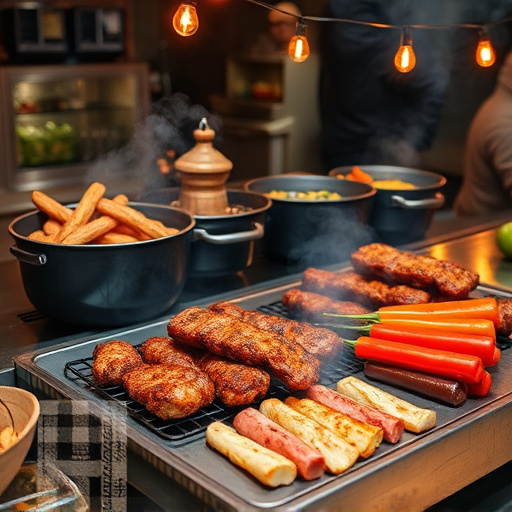
Cooking jerky on a grill is an art that requires attention to detail for achieving that perfect, evenly roasted texture. One of the key tips is to maintain a consistent temperature—around 225°F (107°C)—to prevent overcooking or burning. Use a meat thermometer to monitor the internal temperature of your jerky; it should reach approximately 160°F (71°C) for beef and 145°F (63°C) for poultry before moving on to the final stage of cooking at a higher heat to achieve that delightful crispiness.
Marinating your meat ahead of time is another crucial step, as it not only adds flavor but also helps tenderize the jerky. Opt for a BBQ sauce base with ingredients like soy sauce, brown sugar, garlic, and paprika for that smoky summer taste. Once marinated, place your meat on the grill grates, ensuring even exposure to heat. Use the indirect cooking method, where hot coals or wood chips are placed on one side of the grill, allowing for gentle, even roasting. Occasionally flip and rotate the jerky slices to promote uniform browning.
Storage and Shelf Life of Homemade BBQ Jerky

When it comes to storing your homemade BBQ jerky recipe, it’s best to keep it in an airtight container at room temperature. Avoid exposing it to direct sunlight or extreme heat, as this can accelerate spoilage. In ideal conditions, your jerky should last for up to a week. However, if you’ve used high-quality ingredients and properly seasoned the meat, it can maintain its freshness for even longer—up to two weeks in the fridge or several months frozen.
Remember that while homemade BBQ jerky recipe is delicious, it’s also a dry product. Its shelf life is shorter compared to store-bought varieties due to differences in packaging and processing. Always inspect your jerky before consumption; if it shows signs of mold, off odors, or an unusual texture, it’s best to discard it.
Creative Flavor Variations for Your Summer Grilling
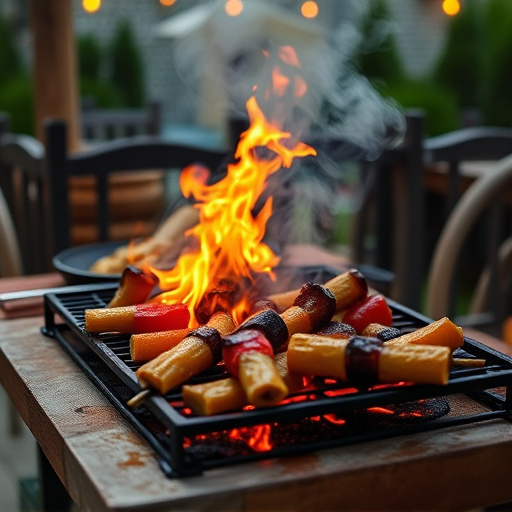
Take your summer grilling to the next level with creative flavor variations on your classic BBQ jerky recipe. Beyond the traditional smoky flavors, experiment with unique combinations like a spicy jalapeño teriyaki twist or a zesty lemon-garlic mix for a refreshing kick. Infuse your jerky with bold tastes from around the world—try adding a touch of Korean gochujang for a spicy and savory Korean BBQ twist, or incorporate Moroccan spices like cumin and paprika for an exotic North African flair.
These creative flavor profiles not only make your backyard BBQs more exciting but also allow you to adapt the recipe to suit various palates. Whether you’re catering to kids who love spice or adults who appreciate a sophisticated twist, there’s a delicious variation of your BBQ jerky recipe waiting to be discovered.
